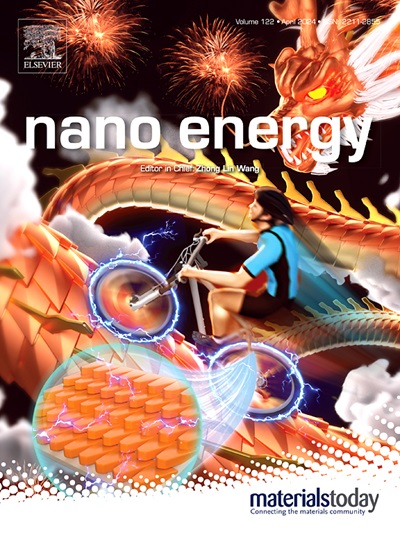Architectural Engineering of Metal-Organic Frameworks in Lithium-Ion Batteries: Multifunctional Roles, Challenges, and Future Perspectives
IF 16.8
1区 材料科学
Q1 CHEMISTRY, PHYSICAL
引用次数: 0
Abstract
Lithium-ion batteries (LIBs) have revolutionized the landscape of portable electronics and electric vehicles, owing to their exceptional energy density, rapid charging capabilities, and extended cycle life. However, the relentless pursuit of enhanced performance and safety propels the quest for innovative, efficient, and reliable materials for LIBs applications. Metal-organic frameworks (MOFs), with their precisely controllable architectures, diverse pore configurations, and customizable chemical properties, have emerged as a leading contender in the realm of energy storage materials. This review comprehensively examines the transformative potential of Metal-Organic Frameworks (MOFs) in advancing Lithium-Ion Batteries (LIBs), focusing on their multifunctional roles as electrodes, electrolytes, and separators. MOFs' unique structural properties—such as tunable porosity, high surface area, and customizable chemical functionalities—enable significant improvements in energy density, ion transport, and thermal stability. The study highlights innovative applications, including MOF-derived carbon coatings for silicon anodes, conductive MOF-enhanced cathodes, and MOF-based solid-state electrolytes for dendrite suppression. Despite these advancements, challenges such as intrinsic low conductivity, structural degradation during cycling, and high production costs remain critical barriers. To address these limitations, the review proposes strategic research directions, including the integration of conductive networks, development of multifunctional hybrid materials, and sustainable synthesis methods. By bridging fundamental research with practical applications, this work provides a roadmap for leveraging MOFs to design next-generation LIBs with enhanced performance, safety, and environmental sustainability.

锂离子电池中金属有机框架的建筑工程:多功能角色、挑战和未来展望
锂离子电池(lib)由于其卓越的能量密度、快速充电能力和延长的循环寿命,已经彻底改变了便携式电子产品和电动汽车的格局。然而,对增强性能和安全性的不懈追求推动了对创新,高效和可靠的lib应用材料的追求。金属有机框架(mof)以其精确可控的结构、多样的孔隙结构和可定制的化学性质,已经成为储能材料领域的主要竞争者。本文全面探讨了金属有机框架(MOFs)在推进锂离子电池(lib)方面的变革潜力,重点介绍了它们作为电极、电解质和隔膜的多功能作用。mof具有独特的结构特性,如可调孔隙度、高表面积和可定制的化学功能,可以显著改善能量密度、离子传输和热稳定性。该研究强调了创新应用,包括用于硅阳极的mof衍生碳涂层,导电mof增强阴极,以及用于抑制枝晶的mof基固态电解质。尽管取得了这些进步,但诸如固有的低导电性、循环过程中的结构降解和高生产成本等挑战仍然是关键的障碍。针对这些局限性,本文提出了导电网络的集成、多功能杂化材料的开发和可持续合成方法等战略研究方向。通过将基础研究与实际应用相结合,这项工作为利用mof设计具有更高性能、安全性和环境可持续性的下一代lib提供了路线图。
本文章由计算机程序翻译,如有差异,请以英文原文为准。
求助全文
约1分钟内获得全文
求助全文
来源期刊

Nano Energy
CHEMISTRY, PHYSICAL-NANOSCIENCE & NANOTECHNOLOGY
CiteScore
30.30
自引率
7.40%
发文量
1207
审稿时长
23 days
期刊介绍:
Nano Energy is a multidisciplinary, rapid-publication forum of original peer-reviewed contributions on the science and engineering of nanomaterials and nanodevices used in all forms of energy harvesting, conversion, storage, utilization and policy. Through its mixture of articles, reviews, communications, research news, and information on key developments, Nano Energy provides a comprehensive coverage of this exciting and dynamic field which joins nanoscience and nanotechnology with energy science. The journal is relevant to all those who are interested in nanomaterials solutions to the energy problem.
Nano Energy publishes original experimental and theoretical research on all aspects of energy-related research which utilizes nanomaterials and nanotechnology. Manuscripts of four types are considered: review articles which inform readers of the latest research and advances in energy science; rapid communications which feature exciting research breakthroughs in the field; full-length articles which report comprehensive research developments; and news and opinions which comment on topical issues or express views on the developments in related fields.
 求助内容:
求助内容: 应助结果提醒方式:
应助结果提醒方式:


